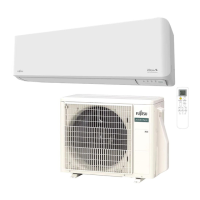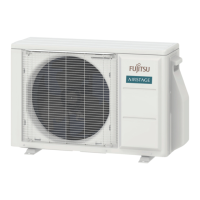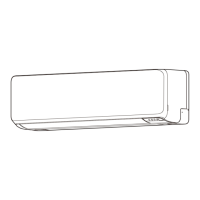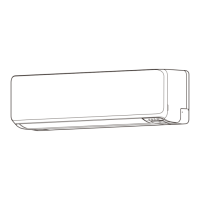En-6
3.3.5. Pipe connection
CAUTION
Tighten the are nuts with a torque wrench using the specied tightening method.
Otherwise, the are nuts could break after a prolonged period, causing refrigerant to
leak and generate hazardous gas if the refrigerant comes into contact with a ame.
■
Flaring
Use special pipe cutter and are tool exclusive for R410A.
(1) Cut the connection pipe to the necessary length with a pipe cutter.
(2) Hold the pipe downward so that cuttings will not enter the pipe and remove any burrs.
(3) Insert the are nut (always use the are nut attached to the indoor unit(s) and outdoor
unit respectively) onto the pipe and perform the are processing with a are tool. Use
the special R410A are tool, or the conventional are tool. Leakage of refrigerant may
result if other are nuts are used.
(4) Protect the pipes by pinching them or with tape to prevent dust, dirt, or water from
entering the pipes.
Die
A
Pipe
B
L
Check if [L] is flared uniformly
and is not cracked or scratched.
Pipe outside diameter
[in (mm)]
Dimension A [in (mm)]
Dimension B [in (mm)]
Flare tool for R410A,
clutch type
1/4 (6.35)
0 to 0.020
(0 to 0.5)
3/8 (9.1)
3/8 (9.52)
1/2 (13.2)
1/2 (12.70)
5/8 (16.6)
5/8 (15.88)
3/4 (19.7)
3/4 (19.05)
15/16 (24.0)
When using conventional are tools to are R410A pipes, the dimension A should be
approximately 0.020 in (0.5 mm) more than indicated in the table (for aring with R410A
flare tools) to achieve the specified flaring. Use a thickness gauge to measure the
dimension A.
Width across
flats
Pipe outside
diameter [in (mm)]
Width across flats of
Flare nut [in (mm)]
1/4 (6.35)
11/16 (17)
3/8 (9.52)
7/8 (22)
1/2 (12.70)
1 (26)
5/8 (15.88)
1-1/8 (29)
3/4 (19.05)
1-7/16 (36)
■
Bending pipes
CAUTION
• To prevent breaking of the pipe, avoid sharp bends.
• If the pipe is bent repeatedly at the same place, it will break.
• The pipes are shaped by your hands. Be careful not to collapse them.
• It is recommended to use a pipe bender to bend R2-3/4 in (R70 mm) or more.
• Do not bend the pipes in an angle more than 90°.
• When pipes are repeatedly bend or stretched, the material will harden, making it difcult
to bend or stretch them anymore.
• Do not bend or stretch the pipes more than 3 times.
• When bending the pipe, do not bend it as
is. The pipe will be collapsed. In this case,
cut the insulating pipe with a sharp cutter
as shown on the right, and bend it after
exposing the pipe. After bending the pipe
as you want, be sure to put the heat insu-
lating pipe back on the pipe, and secure it
with tape.
Pipe
Insulating
pipe
Cutter
Cut line
■
Flare connection
CAUTION
• Be sure to install the pipe against the port on the indoor unit correctly. If the center-
ing is improper, the are nut cannot be tightened smoothly. If the are nut is forced
to turn, the threads will be damaged.
• Do not remove the are nut from the indoor unit pipe until immediately before con-
necting the connection pipe.
• Hold the torque wrench at its grip, keeping it in the right angle with the pipe, in order
to tighten the are nut correctly.
• Tighten the are nuts with a torque wrench using the specied tightening method.
Otherwise, the are nuts could break after a prolonged period, causing refrigerant to
leak and generate hazardous gas if the refrigerant comes into contact with a ame.
• Connect the piping so that the control box cover can easily be removed for servic-
ing when necessary.
• In order to prevent water from leaking into the control box, make sure that the pip-
ing is well insulated.
When the flare nut is tightened properly by your hand, hold the body side coupling with
a wrench, then tighten with a torque wrench. (Refer to the following table for the flare nut
tightening torques.)
Tighten with two wrenches.
Holding wrench
Flare nut
Connection pipe
Torque wrench
Indoor unit pipe
(Body side)
Flare nut [in (mm)] Tightening torque [lb·ft (N·m)]
1/4 (6.35) dia. 11.8 to 13.3 (16 to 18)
3/8 (9.52) dia. 23.6 to 31.0 (32 to 42)
1/2 (12.70) dia. 36.1 to 45.0 (49 to 61)
5/8 (15.88) dia. 46.5 to 55.3 (63 to 75)
3/4 (19.05) dia. 66.4 to 81.1 (90 to 110)
3.4. Electrical wiring
WARNING
• Before connecting the wires, make sure the power supply is OFF.
• Every wire must be connected rmly.
• No wire should be allowed to touch refrigerant tubing, the compressor or any mov-
ing part.
• Loose wiring may cause the terminal to overheat or result in unit malfunction. A re
hazard may also exist. Therefore, be sure all wiring is tightly connected.
• Connect wires to the matching numbers of terminals.
3.4.1. Wiring system diagram
INDOOR UNIT SIDE
Ground
(earth) line
DISCONNECT
SWITCH
(
Locally purchased
)
OUTDOOR UNIT
or BRANCH BOX
Connect it to
the specied
terminal.
INDOOR UNIT
TERMINAL
Power line
Control line
Ground
(earth)
screw
Indoor unit terminal block
Disconnect switch
Connect it to the
specified termi-
nal.
Outdoor unit or
Branch box
9387082593-01_IM.indb 69387082593-01_IM.indb 6 28-Oct-21 13:52:5028-Oct-21 13:52:50

